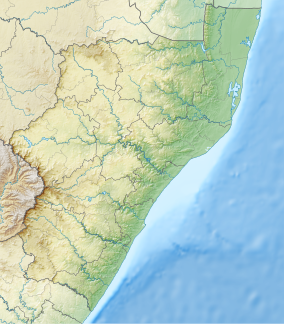Oribi Gorge
This article needs additional citations for verification. (August 2012) |
| Oribi Gorge | |
|---|---|
 View from near Baboon's Castle, Oribi gorge | |
Oribi Gorge on the map of KwaZulu-Natal | |
| Location | KwaZulu-Natal, South Africa |
| Coordinates | 30°43′11″S 30°16′12″E / 30.7197°S 30.27°E / -30.7197; 30.27[1] |

Oribi Gorge is a canyon in southern KwaZulu-Natal, South Africa, 35 kilometres north-west of Port Shepstone, which itself is 120 km south of Durban. Oribi Gorge, cut by the Mzimkulwana River, is the eastern gorge of two gorges that cut through the Oribi Flats (flat sugarcane farmlands) of KwaZulu-Natal. The western gorge was formed by the Mzimkulu River. The gorge is approximately 400 metres (1,300 ft) deep, and almost 5 kilometres (3.1 mi) wide at its widest.
Erosion by these rivers have carved out nearly 30 kilometres (19 mi) of spectacular kloofs and crags, covered with subtropical vegetation.[2] In the gorge, the dense forest on the sandstone slopes is home to various small mammals, while the large leguaans excavate their burrows along the riverbanks.[3]
At the base of the cliffs of both gorges the basement rocks are part of the Namaqua-Natal Metamorphic Province, which is over 1000 million years old. The cliffs themselves are formed by Msikaba formation sandstones deposited by fluvial environment about 365 million years ago.[4] Downstream from the gorges, is a large surface mine producing cement from a limestone deposit. The road through Oribi Gorge was built by Italian prisoners of war.
Oribi Gorge derives its name from the oribi, a small antelope that lives in the gorges.
Oribi Gorge Nature Reserve

Oribi Gorge Nature Reserve is a park located along the bottom of the Oribi Gorge at the confluence of the Mzimkulu River and Mximkulwana River, being approximately 27 kilometres (17 mi) long, and 1 kilometre (0.62 mi) wide at its widest point. It was proclaimed a protected state forest in 1950.[5]: 330
Animals
In addition to the oribi and monitor lizards, vertebrates include bushbuck, duiker, reedbuck, vervet monkeys, Samango monkeys, various frogs and turtles.[6]
References
- ^ "Oribi Gorge Provincial Nature Reserve". protectedplanet.net.
- ^ Glen, H. F. (1996). "A description of the vegetation of Oribi Gorge Nature Reserve, Natal, part I". Trees in South Africa. 46. Johannesburg, South Africa: Tree Society of Southern Africa: 18–27.
- ^ Bayless, Mark K. (2002). "Monitor lizards: a pan‐African check‐list of their zoogeography (Sauria: Varanidae: Polydaedalus)". Journal of Biogeography. 29 (12): 1643–1701. doi:10.1046/j.1365-2699.2002.00779.x.
- ^ Thomas, R. J. (1988). "The petrology of the Oribi Gorge Suite; Kibaran charnockitic granitoids from southern Natal". South African Journal of Geology. 91 (2): 275–291.
- ^ Illustrated guide to Southern Africa. Internet Archive. Cape Town : Reader's Digest Association South Africa in association with T.V. Bulpin. 1980. ISBN 978-0-620-04650-3.
{{cite book}}: CS1 maint: others (link) - ^ Bourquin, O. & Mathias, I. (1994). "The vertebrates of Oribi Gorge Nature Reserve: 1". The Lammergeyer. 33: 35–44.
External links
- Ezemvelo KZN Wildlife (previously known as Natal Parks Board)
- Oribi Gorge Information Page
- 360 degree Virtual Tour of Oribi Gorge







